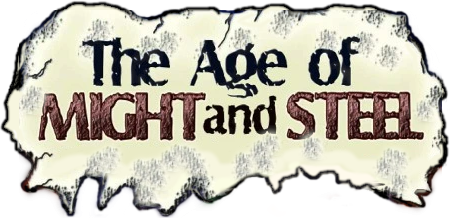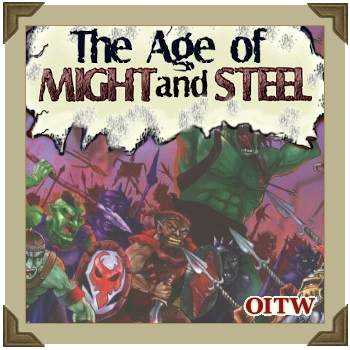
"Errata for 2nd Edition"
by Gavin Syme & Steve Hazuka

AoMaS has hundreds of loyal players around the world and, as with any ruleset, questions often arise asking for clarifications on certain rules. In this article the games creator, Steve Hazuka, and Alternative Armies' Gavin Syme answer those questions for you.
~
If you have any questions you feel you want to ask and that you cannot see an answer to please let us know or comment on this article for an offical answer.
~
When I am basing up my miniatures for AoMaS can I use those I have already based up for HOTT 2nd Edition as they are or do I have to re-base them?
In Age of Might and Steel all miniatures are on Element Bases just as in HOTT and those bases all have a frontage of 40mm width which is also the same. While HOTT requires specific base depth AoMaS allows for some broad strokes in depth. Infantry aim for 20mm depth, cavalry for 30mm and so on but this means that typically you can use exactly the same bases. As for the number of miniatures upon the base these are sometimes the same and sometimes differerent but as long as your players agree to this it will be fine. Remember though that even the largest HOTT Army will be rather small in AoM
~
Is a unit with more than 12 Elements or Stands ever allowed in play?
No. Twelve stands is the limit for any unit in play. There were discussions during the drawing up of second edition about making Undead units that could have fourteen or even sixteen stands but this was dropped as too complex for the mechanics. It might be possible in future expansion
~
I have plans for an Arabian type Human army that uses Camels but I cannot see them in the book. What are they classed as?
In AoMaS Camels could be counted as Heavy Cavalry if you feel they are similar to plate armoured knights with lances or they could be classed a Monsters just like War Mammoths or Elephants are. Personally I think that they are smaller and lighter than Elephants so classing them like horses or war wolves is the way to go. So Camels are heavy cavalry.
~
There is snow on my battlefield. How is this counted for movement in play?
Referring to the movment chart on page ten of the AoMaS book I would count light snow or sand as Rough terrain and deep snow or sand as Dense Woods. If travelling though woods or such which are filled with snow as well then count rate as as its a River. However a frozen river could count as Clear terrain
~
Where is ambush defined/explained in the rules?
These are not in the rules book. An ambush is a formation set up in suitable terrain (such as a section of woods as large as the bases of the whole formation) at games start which the player notes down but the other player does not know about. The Ambush bonuses in the rules are given at the moment the ambush is sprung and then the formation is placed in play as normal at that point. A Charge Order for Ambush must be given to the unit. There is no additional points cost for this. This would be on page 8 of the book if inserted
~
What is the point/advantage of Hide? Where is this explained in the rules?
Hide is given on page 8 of the book. A unit using Hide must be in terrain as per Ambush mechanic. If Hide is in use then the Ambush bonuses are applicable.
~
What is the movement rate for units (not heavy foot) in Attack column formation?
The movement rate of units (not Heavy Foot) in Attack Column is 50% rounding down of their normal movement rate for the applicable terrain type
~
Where do archers fit in the hand to hand combat hierarchy?
Archers count as Light Foot in hand to hand combat.They gain a +1 in defending.
~
What does "only the first 2 lines are involved" mean?
The first two lines means the first two rows of element bases which are facing and encountering the enemy. So if a unit is three elements wide and three deep only six of the nine would be the first 2 Lines.
~
Is the entire unit or only the first two lines counted for outnumbering?
The whole unit is taken into account for outnumbering.
~
What is the significance of the first two lines in combat?
The first two lines in combat are the ones which enter into the combat and are counted in melee.
~
Where do the rules say that the attacker's losses are the base number? (posts in this group indicate that this is the way it should be played).
Page 13 bottom right paragraphs. The base number is modified by those elements and once the final base number is worked out (for example 4) then page 13 bottom left states the losses in element bases to the unit are the difference in the numbers rolled. For the attacker is it ONE if the difference is 1, TWO if the difference is 2, and TWO if the difference is 3 or more
~
How does this reconcile with the statement "the attacker loses 1 or 2 stands depending on the base number", when the base number could be zero or 3 or more?
As above. It’s not made clear but this is how it works. Attacker loses 1 or 2 or 0 with greater numeric differences being brought back to 0,1 or 2.
~
Where are the negative die modifiers listed for hand to hand combat?
Page 13 and left column page 14 give all positive and negative modifiers for hand to hand. There are no more in the core rules. Types of weapons typically do not make a difference only number of elements and broad unit type.
~
What is the point of the cavalry charging -1 modifier if it is not cumulative with unit charging?
That is the way Steve Hazuka wrote the rules. I do not agree with this mechanic but I do play it as it is written. I assume it to be his opinion on Cavalry in play.
~
On page 18 of the AoMaS book it says that Dragons love to fight other Dragons and will seek them out when in play. How does this work in play?
Dragons are proud and preening creatures which hold a special place in the heart of the author of Age of Might and Steel. In play this means quite simply that we want one on one carnage between these monsters. If when the game begins there are dragons on opposite sides of the battle they will attack each other over any other priority. So when activated the Dragon will move towards and then attack the other Dragon regardless of any unit in its way or any other attacks made upon it.
~
Webmaster's Notes
This article was originally published on Alternative Armies' content portal Barking Irons Online in 2011 and is reproduced here with permission.
You can buy The Age of Might and Steel rules direct from Alternative Armies on thier web site here.
Barking Irons Online was Alternative Armies' official content portal that I ran for them from 2011 until 2013, You can find (almost) all of the content it hosted on Orcs in the Webbe in the respective categories in the menus or browse through it all by clicking on the maroon "Barking Irons" tag below.
~
